Loading AI tools
化妝品是用來增強人體外貌或增加香味在身體上。許多化妝品被設計使用在臉和頭髮。在21世紀,女人通常使用化妝品多餘男性。化妝品常使用化合物混和,有些從天然衍生而來 (例如:椰子油),而一些是合成的[1] 一般化妝品,包含口紅、睫毛膏、眼影、粉底、胭脂、潔膚產品、乳液、洗髮精、髮型相關產品(如:髮膠、噴髮膠)、 香水、和科隆香水。
| 本草稿尚未完成,内容未必可信。 本草稿未來可能會被移動成為正式內容。 来源搜索:“"沙盒5"”——Google:网页、新闻、学术、图书、图片;百度:网页、新闻、学术、图片;知网工具书;JSTOR;维基百科图书馆 本用户页由Willy1018(贡献·日志)於7年前最后编辑。 |
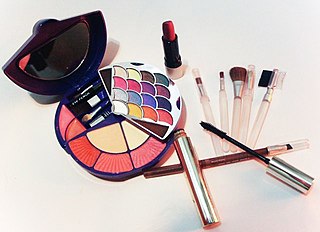


美國食品藥品監督管理局(FDA)規範化妝品,[2] 定義化妝品為:旨在施加到人體用於清潔,美化,提高吸引力,或改變外觀,而不影響人體的結構或功能”。該廣泛規定包含任何製作化妝產品的成分。 美國食品藥物管理局明確規範肥皂不是化妝品這個類別。[3]


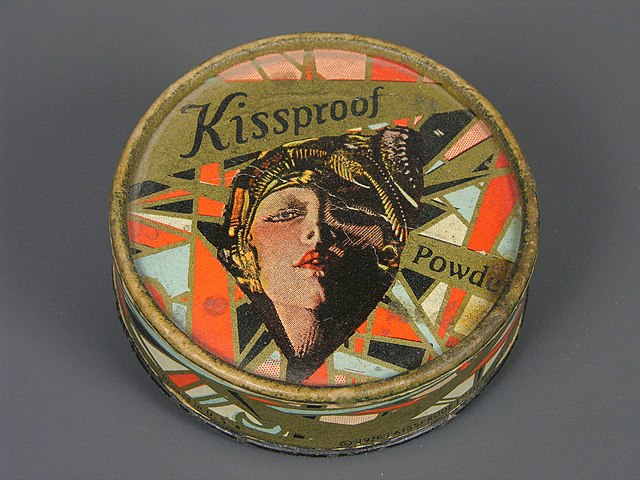
cosmetics derives from the Greek κοσμητικὴ τέχνη (kosmetikē tekhnē), 意思為"technique of dress and ornament", from κοσμητικός (kosmētikos), "skilled in ordering or arranging"[4] and that from κόσμος (kosmos), meaning amongst others "order" and "ornament".[5]
大約 5,000 年前,古蘇美人男女可能是最早發明並使用口紅。[6]他們將寶石擊碎裝飾臉部,不過主要裝飾在唇部和眼睛周圍。[7] 大約西元前3000年至西元前1500年,女人在ancient 印度河流域文明應用紅口紅塗抹在他們唇部,作為臉部裝飾。[8] 古埃及人 extracted red dye from fucus-algin, 0.01% 碘 ,和一些溴 mannite,但這種染料導致嚴重的疾病。口紅with shimmering effects were initially made using a pearlescent substance found in fish scales.[9] 6,000年 old relics of the hollowed out tombs of the Ancient Egyptian pharaohs are discovered.[10] 根據一個可靠來源,早期重大發展包含:[1]
- Kohl在古埃及,當作 a protective of the眼影。
- 蓖麻油在古埃及被當作 a protective balm.
- 霜是由蜂蠟所製作的, 橄欖油和玫瑰水,described by 羅馬書。
- 19世紀凡士林和羊毛脂發明。
古希臘人也使用化妝品[11][12],如同古羅馬人一樣。化妝品 are mentioned in the 旧约圣经,such as in 2 Kings 9:30, where Jezebel painted her eyelids—approximately 840 BC—and in the book of Esther, where beauty treatments are described.
其中最受歡迎的中藥是銀耳,被使用在中國和日本的美容產品。The fungus reportedly increases moisture retention in the skin and prevents senile degradation of micro-blood vessels in the skin, reducing wrinkles and smoothing fine lines. Other anti-ageing effects come from increasing the presence of superoxide dismutase in the brain and liver; it is an enzyme that acts as a potent antioxidant throughout the body, particularly in the skin.[13]
化妝品 use was frowned upon at many points 在西方歷史。例如:19世紀,Queen Victoria publicly declared makeup improper, vulgar, and acceptable only for use by actors.[14]
在16世紀, the personal attributes of the women who used make-up created a demand for the product among the upper class.[15]
西元2016年,世界最大化妝品公司萊雅(法語:L'Oréal),由Eugène Schueller在1909年成立,as the 法國 Harmless Hair Colouring Company (現在owned by Liliane Bettencourt 26% and Nestlé 28%; the remaining 46% is traded publicly)。這個市場由Elizabeth Ardendeveloped在美國1910年代,Helena Rubinstein,和Max Factor. These firms were joined by Revlon just before 第二次世界大戰and Estée Lauder just after.
在18世紀, there was a high number of incidences of lead-poisoning 因為 the fashion for red and white lead makeup and powder. This led to swelling and inflammation of the eyes, attacked tooth enamel, and caused skin to blacken. Heavy use was known to lead to death.
Although modern make-up has been traditionally used mainly by women, an increasing number of men are using化妝品usually associated to women to enhance or cover their own facial features such as blemishes, dark circles, and so on. Concealer is commonly used by men.[來源請求] Cosmetics brands release products especially tailored for men, and men are increasingly using them.[16]
化妝品 are intended to be applied externally. They include but are not limited to products that can be applied to the face: skin-care creams, lipsticks, eye and facial makeup, towelettes, and colored contact lenses; to the body: deodorants, lotions, powders, perfumes, baby products, bath oils, bubble baths, bath salts, and body butters; to the hands/nails: fingernail and toe nail polish, and hand sanitizer; to the hair: permanent chemicals, hair colors, hair sprays, and gels.
A subset of cosmetics is called "化妝", refers primarily to products containing color pigments that are intended to alter the user’s appearance. Manufacturers may distinguish between "decorative" and "care" cosmetics.
化妝品 that are meant to be used on the face and eye area are usually applied with a brush, a makeup sponge, or the fingertips.
Most cosmetics are distinguished by the area of the body intended for application.
- Primer comes in formulas to suit individual skin conditions. Most are meant to reduce the appearance of pore size, prolong the wear of makeup, and allow for a smoother application of makeup. Primers are applied before foundation or eyeshadows depending on where the primer is to be applied.
- Lipstick, lip gloss, lip liner, lip plumper, lip balm, lip stain, lip conditioner, lip primer, lip boosters, and lip butters:[2] Lipsticks are intended to add color and texture to the lips and often come in a wide range of colors, as well as finishes such as matte, satin, and lustre. Lip stains have a water or gel base and may contain alcohol to help the product stay on leaving a matte look. They temporarily saturate the lips with a dye. Usually designed to be waterproof, the product may come with an applicator brush, rollerball, or could be applied with a finger. Lip glosses are intended to add shine to the lips and may add a tint of color, as well as being scented or flavored for a pop of fun. Lip balms are most often used to moisturize, tint, and protect the lips. Some brands contain sunscreen.
- Concealer makeup covers imperfections of the skin. Concealer is often used for any extra coverage needed to cover blemishes, undereye circles, and other imperfections. Concealer is often thicker and more solid than foundation, and provides longer lasting, more detailed coverage. Some formulations are intended only for the eye or only for the face. This product can also be used for contouring the face like ones nose, cheekbones, and jaw line to add a more defined look to the total face.
- Foundation is used to smooth out the face and cover spots, acne, blemishes, or uneven skin coloration. These are sold in a liquid, cream, or powder, or most recently a mousse. Foundation provides coverage from sheer to matt to dewey or full.[2] Foundation primer can be applied before or after foundation to obtain a smoother finish. Some primers come in powder or liquid form to be applied before foundation as a base, while other primers come as a spray to be applied after the foundation to set the make-up and help it last longer throughout the day.
- Face powder sets the foundation, giving it a matte finish, and to conceal small flaws or blemishes. It can also be used to bake the foundation, so that it stays on longer. Tinted face powders may be worn alone as a light foundation so that the full face does not look as caked-up as it could.
- Rouge, blush, or blusher is cheek coloring to bring out the color in the cheeks and make the cheekbones appear more defined. Rouge comes in powder, cream, and liquid forms. Different blush colors are used to compliment different skin tones.[2]
- Contour powders and creams are used to define the face. They can give the illusion of a slimmer face or to modify a face shape in other desired ways. Usually a few shades darker than the skin tone and matte in finish, contour products create the illusion of depth. A darker-toned foundation/concealer can be used instead of contour products for the same purpose.
- Highlight, used to draw attention to the high points of the face as well as to add glow, comes in liquid, cream, and powder forms. It often contains a substance to provide shimmer. Alternatively, a lighter-toned foundation/concealer can be used.
- Bronzer gives skin a bit of color by adding a golden or bronze glow and highlighting the cheekbones, as well as being used for contouring. Bronzer is considered to be more of a natural look and can be used for an everyday wear. Bronzer enhances the color of the face while adding more of a shimmery look.[2] It comes in either matte, semi matte/satin, or shimmer finishes.
- Mascara is used to darken, lengthen, thicken, or draw attention to the eyelashes. It is available in various colors. Some mascaras include glitter flecks. There are many formulas, including waterproof versions for those prone to allergies or sudden tears. It is often used after an eyelash curler and mascara primer.[2] Many mascaras have components to help lashes appear longer and thicker.

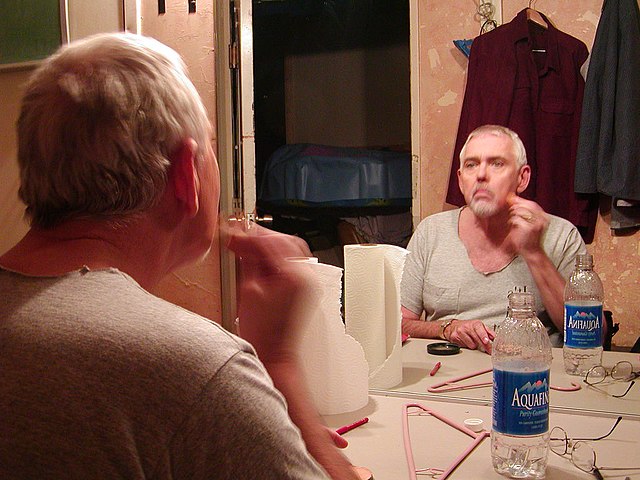

- Eye liner is used to enhance and elongate the apparent size or depth of the eye. For example, white eyeliner on the waterline and inner corners of the eye makes the eyes look bigger and more awake.
- Eyebrow pencils, creams, waxes, gels, and powders are used to color, fill in, and define the brows.[2]
- Nail polish is used to color the fingernails and toenails.[2] Transparent, colorless versions may strengthen nails or as a top or base coat to protect the nail or polish.
- Setting spray is used as the last step in the process of applying makeup. It keeps applied makeup intact for long periods. An alternative to setting spray is setting powder, which may be either pigmented or translucent. Both of these products are claimed to keep makeup from absorbing into the skin or melting off.
- False eyelashes are used when exaggerated eyelashes are desired. Their basic design usually consists of human hair or synthetic materials attached to a thin cloth-like band, which is applied with glue to the lashline. Designs vary in length and color. Rhinestones, gems, and even feathers and lace occur on some false eyelash designs.
Cosmetics can be also described by the physical composition of the product. Cosmetics can be liquid or cream emulsions; powders, both pressed and loose; dispersions; and anhydrous creams or sticks.
Makeup remover is a product used to remove the makeup products applied on the skin. It cleans the skin before other procedures, like applying bedtime lotion.
Cleansing is a standard step in skin care routines.皮膚清潔包含一些 or all of these 步驟或化妝品:
- Toners are used after cleansing the skin to freshen it up, boost the appearance of one's complexion, and remove any traces of cleanser, mask, or makeup, as well to help restore the skin's natural pH. They are usually applied to a cotton pad and wiped over the skin, but can be sprayed onto the skin from a spray bottle. Toners typically contain alcohol, water, and herbal extracts or other chemicals depending on skin type whether oily, dry, or combination. Toners containing alcohol are quite astringent, and usually targeted at oily skins. Dry or normal skin should be treated with alcohol-free toners. Witch hazel solution is a popular toner for all skin types, but many other products are available. Many toners contain salicylic acid and/or benzoyl peroxide. These types of toners are targeted at oily skin types, as well as acne-prone skin.[來源請求]
- Facial masks are treatments applied to the skin and then removed. Typically, they are applied to a dry, cleansed face, avoiding the eyes and lips.
- Clay-based masks use kaolin clay or fuller's earth to transport essential oils and chemicals to the skin, and are typically left on until completely dry. As the clay dries, it absorbs excess oil and dirt from the surface of the skin and may help to clear blocked pores or draw comedones to the surface. Because of its drying actions, clay-based masks should only be used on oily skins.
- Peel masks are typically gel-like in consistency, and contain acids or exfoliating agents to help exfoliate the skin, along with other ingredients to hydrate, discourage wrinkles, or treat uneven skin tone. They are left on to dry and then gently peeled off. They should be avoided by people with dry skin, as they tend to be very drying.
- Sheet masks are a relatively new product that are becoming extremely popular in Asia. Sheet masks consist of a thin cotton or fiber sheet with holes cut out for the eyes and lips and cut to fit the contours of the face, onto which serums and skin treatments are brushed in a thin layer; the sheets may be soaked in the treatment. Masks are available to suit almost all skin types and skin complaints. Sheet masks are quicker, less messy, and require no specialized knowledge or equipment for their use compared to other types of face masks, but they may be difficult to find and purchase outside Asia.
- Exfoliants are products that help slough off dry, dead skin cells to improve the skin's appearance. This is achieved either by using mild acids or other chemicals to loosen old skin cells, or abrasive substances to physically scrub them off. Exfoliation can even out patches of rough skin, improve circulation to the skin, clear blocked pores to discourage acne and improve the appearance and healing of scars.
- Chemical exfoliants may include citric acid (from citrus fruits), acetic acid (from vinegar), malic acid (from fruit), glycolic acid, lactic acid, or salicylic acid. They may be liquids or gels, and may or may not contain an abrasive to remove old skin cells afterwards.
- Abrasive exfoliants include gels, creams or lotions, as well as physical objects. Loofahs, microfiber cloths, natural sponges, or brushes may be used to exfoliate skin, simply by rubbing them over the face in a circular motion. Gels, creams, or lotions may contain an acid to encourage dead skin cells to loosen, and an abrasive such as microbeads, sea salt, sugar, ground nut shells, rice bran, or ground apricot kernels to scrub the dead cells off the skin. Salt and sugar scrubs tend to be the harshest, while scrubs containing beads or rice bran are typically very gentle.
- Moisturizers are creams or lotions that hydrate the skin and help it to retain moisture; they may contain essential oils, herbal extracts, or chemicals to assist with oil control or reducing irritation. Night creams are typically more hydrating than day creams, but may be too thick or heavy to wear during the day, hence their name. Tinted moisturizers contain a small amount of foundation, which can provide light coverage for minor blemishes or to even out skin tones. They are usually applied with the fingertips or a cotton pad to the entire face, avoiding the lips and area around the eyes. Eyes require a different kind of moisturizer compared with the rest of the face. The skin around the eyes is extremely thin and sensitive, and is often the first area to show signs of aging. Eye creams are typically very light lotions or gels, and are usually very gentle; some may contain ingredients such as caffeine or Vitamin K to reduce puffiness and dark circles under the eyes. Eye creams or gels should be applied over the entire eye area with a finger, using a patting motion.
There are two categories of personal care products. The Federal Food, Drug, and Cosmetic Act defines cosmetics as products intended to cleanse or beautify (for instance, shampoos and lipstick). A separate category exists for medications, which are intended to diagnose, cure, mitigate, treat, or prevent disease, or to affect the structure or function of the body (for instance, sunscreens and acne creams). Some products, such as moisturizing sunscreens and anti-dandruff shampoos, are regulated within both categories.[17][18]
A variety of organic compounds and inorganic compounds comprise typical cosmetics. Typical organic compounds are modified natural oils and fats as well as a variety of petrochemically derived agents. Inorganic compounds are processed minerals such as iron oxides, talc, and zinc oxide. The oxides of zinc and iron are classified as pigments, i.e. colorants that have no solubility in solvents.
Handmade and certified organic products are becoming more mainstream, due to the fact that certain chemicals in some skincare products may be harmful if absorbed through the skin. Products claimed to be organic should, in the U.S., be certified "USDA Organic".[19]
The term "mineral makeup" applies to a category of face makeup, including foundation, eye shadow, blush, and bronzer, made with loose, dry mineral powders. These powders are often mixed with oil-water emulsions. Lipsticks, liquid foundations, and other liquid cosmetics, as well as compressed makeups such as eye shadow and blush in compacts, are often called mineral makeup if they have the same primary ingredients as dry mineral makeups. However, liquid makeups must contain preservatives and compressed makeups must contain binders, which dry mineral makeups do not. Mineral makeup usually does not contain synthetic fragrances, preservatives, parabens, mineral oil, and chemical dyes. For this reason, dermatologists may consider mineral makeup to be gentler to the skin than makeup that contains those ingredients.[20] Some minerals are nacreous or pearlescent, giving the skin a shining or sparking appearance. One example is bismuth oxychloride.[1] There are various mineral-based makeup brands, including: Bare Minerals, Tarte, Bobbi Brown, and Stila.
Although the chemical constituent of cosmetics sometimes cause concerns, some chemicals are widely seen as beneficial. 二氧化鈦, found in sunscreens, and 氧化鋅 have anti-inflammatory properties, mineral makeups with those ingredients can have a calming effect on the skin, which is particularly important for those who suffer from inflammatory problems such as rosacea.氧化鋅 is anti-microbial,[21] so mineral makeups can be beneficial for people with acne.
Mineral makeup is noncomedogenic (as long as it does not contain talc) and offers a mild amount of sun protection (because of the titanium dioxide and zinc oxide).[22]
因為他們不 contain 易體ingredients, mineral makeups have long shelf-lives.
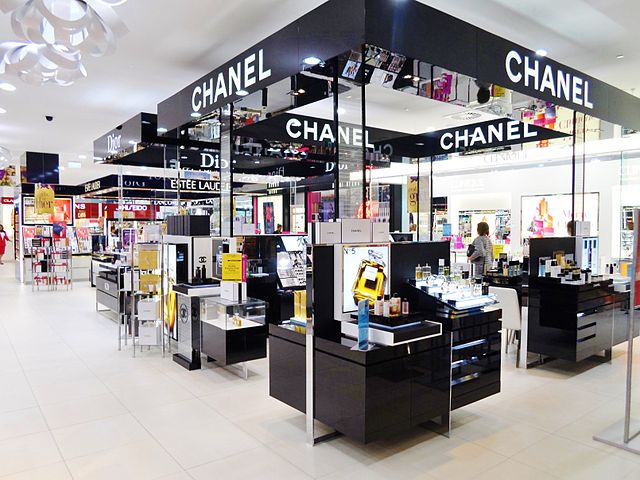
The manufacture of cosmetics is dominated by a small number of multinational corporations that originated in the early 20th century, but the distribution and sale of cosmetics is spread among a wide range of businesses. The worlds largest cosmetic companies are L'Oréal, Procter & Gamble, Unilever, Shiseido, and Estée Lauder.[23] In 2005, the market volume of the cosmetics industry in the美國, 歐盟, and 日本 was about EUR 70B/y.[1] In德國, the cosmetic industry generated €12.6 billion of retail sales in 2008,[24] which makes the German cosmetic industry the third largest in the world, after Japan and the United States. German exports of cosmetics reached €5.8 billion in 2008, whereas imports of cosmetics totaled €3 billion.[24]
The worldwide cosmetics and perfume industry currently generates an estimated annual turnover of US$170 billion (according to Eurostaf – May 2007). Europe is the leading market, representing approximately €63 billion, while sales in France reached €6.5 billion in 2006, according to FIPAR (Fédération des Industries de la Parfumerie – the French federation for the perfume industry).[25] France is another country in which the cosmetic industry plays an important role, both nationally and internationally. According to data from 2008, the cosmetic industry has grown constantly in France for 40 consecutive years. In 2006, this industrial sector reached a record level of €6.5 billion. Famous cosmetic brands produced in France include Vichy, Yves Saint Laurent, Yves Rocher, and many others.
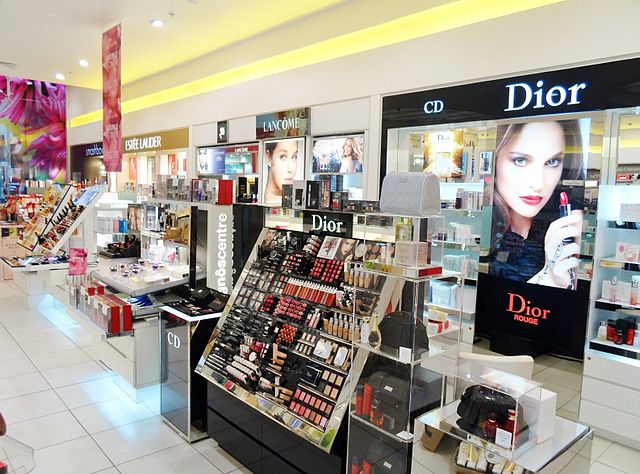
The Italian cosmetic industry is also an important player in the European cosmetic market. Although not as large as in other European countries, the cosmetic industry in Italy was estimated to reach €9 billion in 2007.[26] The Italian cosmetic industry is dominated by hair and body products and not makeup as in many other European countries. In Italy, hair and body products make up approximately 30% of the cosmetic market. Makeup and facial care, however, are the most common cosmetic products exported to the United States.
Due to the popularity of cosmetics, especially fragrances and perfumes, many designers who are not necessarily involved in the cosmetic industry came up with perfumes carrying their names. Moreover, some actors and singers (such as Celine Dion) have their own perfume line. Designer perfumes are, like any other designer products, the most expensive in the industry as the consumer pays for the product and the brand. Famous Italian fragrances are produced by Giorgio Armani, Dolce & Gabbana, and others.
Procter & Gamble, which sells CoverGirl and Dolce & Gabbana makeup, funded a study[27] concluding that makeup makes women seem more competent.[28] Due to the source of funding, the quality of this Boston University study is questioned.
在20世紀, the popularity of cosmetics increased rapidly.[29] Cosmetics are increasingly used by girls at a young age, especially in the United States.[30] Due to the fast-decreasing age of make-up users, many companies, from high-street brands like Rimmel to higher-end products like Estee Lauder, cater to this expanding market by introducing flavored lipsticks and glosses, cosmetics packaged in glittery and sparkly packaging, and marketing and advertising using young models.[31] The social consequences of younger and younger cosmetics use has had much attention in the media over the last few years.
Criticism of cosmetics has come from a wide variety of sources including some feminists,[32] religious groups, animal rights activists, authors, and public interest groups.
在美國: "根據法律規定, 化妝品和配料不需要FDA的上市批准。"[33] The EU and other regulatory agencies around the world have more stringent regulations.[34] The FDA does not have to approve or review cosmetics, or what goes in them, before they are sold to the consumers. The FDA only regulates against some colors that can be used in the cosmetics and hair dyes. The cosmetic companies do not have to report any injuries from the products; they also only have voluntary recalls of products.[35]
There has been a marketing trend towards the sale of cosmetics lacking controversial ingredients, especially those derived from petroleum, sodium lauryl sulfate (SLS), and parabens.[36] Numerous reports have raised concern over the safety of a few surfactants, including 2-Butoxyethanol. SLS causes a number of skin problems, including dermatitis.[37][38][39][40][41]
Parabens 可能造成skin irritation and contact dermatitis in individuals with paraben allergies, a small percentage of the general population.[42] Animal experiments have shown that parabens have a weak estrogenic activity, acting as xenoestrogens.[43]

Synthetic fragrances are widely used in consumer products. Studies concluded from patch testing show synthetic fragrances are made of many ingredients which cause allergic reactions.[44]
Balsam of Peru was the main recommended marker for perfume allergy before 1977, which is still advised. The presence of Balsam of Peru in a cosmetic will be denoted by the INCI term Myroxylon pereirae.[45][46] In some instances, Balsam of Peru is listed on the ingredient label of a product by one of its various names, but it may not be required to be listed by its name by mandatory labeling conventions (in fragrances,舉例來說, it may simply be covered by an ingredient listing of "fragrance").[47][48][49][50]
Cosmetics companies make pseudo-scientific claims about their products which are misleading or unsupported by scientific evidence.[51][52]
化妝品動物測試 is particularly controversial. Such tests involve general toxicity, 眼 and skin irritancy, phototoxicity (toxicity triggered by ultraviolet light), and mutagenicity.[53]
在2002年,荷蘭、比利時、 歐盟禁止化妝品產品測試。在13年討論後,歐盟 (EU) 允許 to phase in a near-total ban on the sale of 化妝品動物性測試throughout the 歐盟from 2009, and to ban all cosmetics-related 動物測試 法國, which is home to the世界上最大的化妝品公司L'Oréal, has protested the proposed ban by lodging a case at the European Court of Justice in Luxembourg, asking that the ban be quashed.[54] The ban is also opposed by the European Federation for Cosmetics Ingredients, which represents 70 companies in 瑞士, 比利時, 法國, 德國, 和 義大利.[54]
模板参数错误!(代码34)
|
在歐盟, 製造,labelling,和申請化妝品 and personal care products are Regulated by Regulation EC 1223/2009.[55] 它應用在所有歐盟的國家,像是: Iceland, Norway, and Switzerland. This regulation 應用在to single-person companies making or importing just one product as well as to large multinationals. Manufacturers and importers of cosmetic products must comply with the applicable regulations in order to sell their products in the EU. In this industry, it is common fall back on a suitably qualified person, such as an independent third party inspection and testing company, to verify the cosmetics’ compliance with the requirements of applicable cosmetic regulations and other relevant legislation,包含 REACH, GMP, hazardous substances, etc.[56]
在歐盟,the circulation of化妝品產品和安全性 has been a subject of legislation 自1976年。 One of the newest improvement of the regulation concerning cosmetic industry is a result of the ban animal testing. 化妝品動物實驗 has been illegal in the 歐盟,自2004年9月, and testing the separate ingredients of such products on animals is also prohibited by法律, 自2009年3月 for some endpoints and full since 2013.[57]
歐盟化妝品立法 are often updated to follow the trends of innovations and new technologies while ensuring product safety. For instance, all annexes of the Regulation 1223/2009 were aimed to address potential risks to human health. Under the EU cosmetic regulation, manufacturers, retailers, and importers of cosmetics in 歐盟 will be designated as “Responsible Person”.[58] This new status implies that the responsible person has the legal liability to ensure that the cosmetics and brands they manufacture or sell comply with the current cosmetic regulations and norms. The responsible person is also responsible of the documents contained in the Product Information File (PIF), a list of product information including data such as Cosmetic Product Safety Report, product description, GMP statement, or product function.
西元1938年, the U.S. passed the Food, Drug, and Cosmetic Act authorizing the Food and Drug Administration (FDA) to oversee safety via legislation in the cosmetic industry and its aspects in the United States.[59][60] The FDA joined with 13 other federal agencies in forming the Interagency Coordinating Committee on the Validation of Alternative Methods (ICCVAM) in 1997, which is an attempt to ban animal testing and find other methods to test cosmetic products.[61]
ANVISA (Agência Nacional de Vigilância Sanitária, Brazilian Health Surveillance Agency) is the regulatory body responsible for cosmetic legislation and directives in the country. The rules apply to manufacturers, importers, and retailers of cosmetics in Brazil, and most of them have been harmonized so they can apply to the entire Mercosur.
The current legislation restricts the use of certain substances such as pyrogallol, formaldehyde, or paraformaldehyde and bans the use of others such as lead acetate in cosmetic products. All restricted and forbidden substances and products are listed in the regulation RDC 16/11 and RDC 162, 09/11/01.
More recently, a new cosmetic Technical Regulation (RDC 15/2013) was set up to establish a list of authorized and restricted substances for cosmetic use, used in products such as hair dyes, nail hardeners, or used as product preservatives.
Most Brazilian regulations are optimized, harmonized, or adapted in order to be applicable and extended to the entire Mercosur economic zone.
The International Organization for Standardization (ISO) published new guidelines on the safe manufacturing of cosmetic products under a Good Manufacturing Practices (GMP) regime. Regulators in several countries and regions have adopted this standard, ISO 22716:2007, effectively replacing existing guidance and standards. ISO 22716 provides a comprehensive approach for a quality management system for those engaged in the manufacturing, packaging, testing, storage, and transportation of cosmetic end products. The standard deals with all aspects of the supply chain, from the early delivery of raw materials and components until the shipment of the final product to the consumer.
The standard is based on other quality management systems, ensuring smooth integration with such systems as ISO 9001 or the British Retail Consortium (BRC) standard for consumer products. Therefore, it combines the benefits of GMP, linking cosmetic product safety with overall business improvement tools that enable organisations to meet global consumer demand for cosmetic product safety certification.[62]
In July 2012, since microbial contamination is one of the greatest concerns regarding the quality of cosmetic products, the ISO has introduced a new standard for evaluating the antimicrobial protection of a cosmetic product by preservation efficacy testing and microbiological risk assessment.

An account executive is responsible for visiting department and specialty stores with counter sales of cosmetics. They explain new products and "gifts with purchase" arrangements (free items given out upon purchase of cosmetics items costing over some set amount).
A beauty adviser provides product advice based on the client's skin care and makeup requirements. Beauty advisers can be certified by an Anti-Aging Beauty Institute.
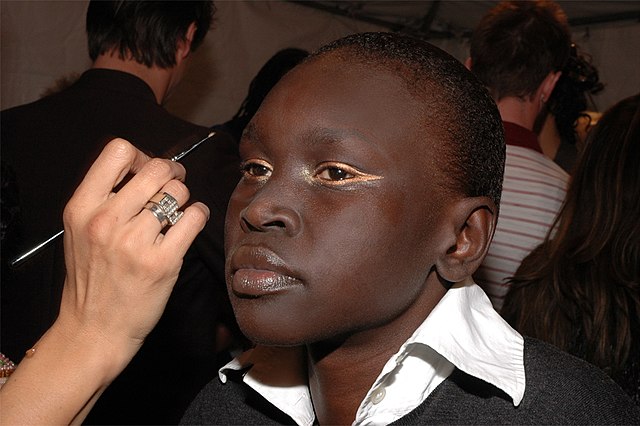
A cosmetician is a professional who provides facial and body treatments for clients. The term cosmetologist is sometimes used interchangeably with this term, but the former most commonly refers to a certified professional. A freelance make-up artist provides clients with beauty advice and cosmetics assistance. They are usually paid by the hour by a cosmetic company; however, they sometimes work independently.
Professionals in cosmetics marketing careers manage research focus groups, promote the desired brand image, and provide other marketing services (sales forecasting, allocation to retailers, etc.).
Many involved within the cosmetics industry often specialize in a certain area of cosmetics such as special effects makeup or makeup techniques specific to the film, media, and fashion sectors.
- Airbrush makeup
- Body art
- Baking
- Cosmeceutical
- Electrotherapy (cosmetic)
- Female cosmetic coalitions
- Henna
- List of cosmetic ingredients
- Maker culture
- Moulage
- Natural skin care
- Permanent makeup
- Sea water gel
- Skin care
Wikiwand in your browser!
Seamless Wikipedia browsing. On steroids.
Every time you click a link to Wikipedia, Wiktionary or Wikiquote in your browser's search results, it will show the modern Wikiwand interface.
Wikiwand extension is a five stars, simple, with minimum permission required to keep your browsing private, safe and transparent.